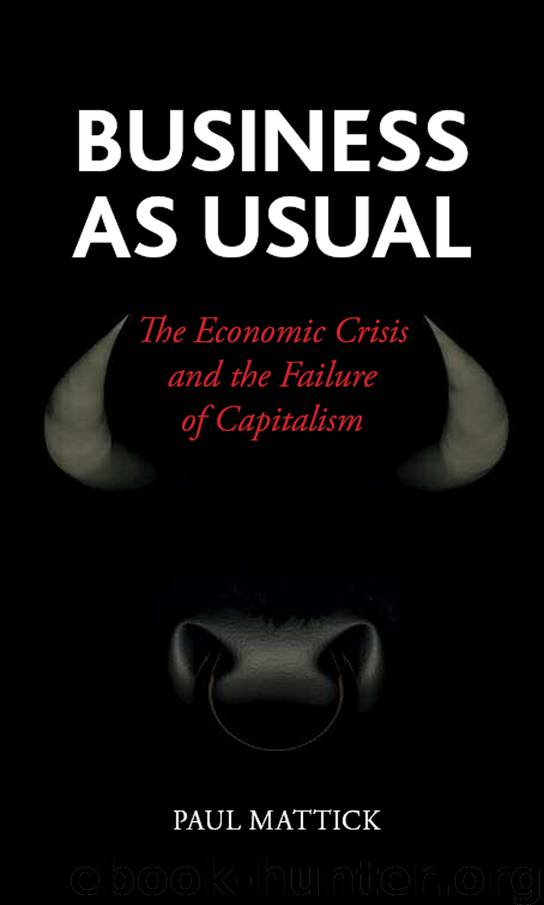Business as Usual by Paul Mattick

Author:Paul Mattick
Language: eng
Format: epub
Publisher: Reaktion Books
Dilemmas of the Mixed Economy
In the immediate post-war years the Keynesian view, enormously strengthened in influence by America’s success in the war, predominated, largely because, in the words of an OECD study, ‘the expansion of the public sector took place within an unusually stable international economic environment and against a background of historically unprecedented rates of economic growth’.13 This changed in the mid-1970s, as the rapid expansion of state economic activity in response to the end of the Golden Age led to the emergence everywhere of budget deficits and the new phenomenon of stagflation, the disturbing combination of economic stagnation with inflation. Public spending, which neither produced anew the high growth rates of the Golden Age nor succeeded in ending poverty, was now held to have ‘detrimental effects on resource allocation, economic incentives, consumer choice, and individual freedom’14 – that is, on the supposed ability of markets to operate efficiently. More concretely, a period of reduced profitability required ‘economic adjustment and flexibility’15 – in other words, an ability to downgrade working conditions and wage levels. The 1980s saw attempts in most capitalist countries to ‘reform’ – that is, curtail – government spending, strikingly paralleled by moves towards the market in the ‘socialist’ world.
As two enthusiasts of such reform are forced to acknowledge in their survey of the question, ‘relatively few countries have so far accompanied their antigovernment rhetoric with successful shifts in their policy regimes toward less state involvement and cuts in public expenditure’.16 This was in part because much of the post-1973 increase in public spending had come in the form of ‘entitlement’ programmes, like old-age pensions, unemployment insurance and disability payments, which were especially difficult to cut in a time of lower growth and increasing unemployment. Education and health spending also tended not just to resist shrinkage but to increase, along with costs of industrial regulation and environmental controls. A large and growing chunk of money was required for the rising interest costs produced by growing deficits (central government expenditure on interest for the world’s leading industrial nations grew from 1.4 per cent to 4.5 per cent of GDP between 1970 and 1995).17 In fact, as one author observes, ‘if debt repayment is taken together with interest payments . . . debt servicing is the largest individual item among the disproportionate increases in state expenditure in the industrial countries of the West’.18
In the United States, to take a spectacular example of the gap between rhetoric and reality, Ronald Reagan came to the presidency in 1980 as an animated symbol of the intention to end deficit spending and the associated inflation. Indeed, the Federal Reserve’s elevation of interest rates succeeded in cutting inflation, but at the cost of a deep recession, with 10.8 per cent unemployment by the end of 1982. By 1983 118 Savings and Loans banks – heavily invested in real-estate speculation – had failed; the next year saw the bankruptcy of the nation’s seventh largest bank, the Continental Illinois National Bank and Trust Company. Federal agencies bailed out the Continental Illinois to the tune of $4.
Download
This site does not store any files on its server. We only index and link to content provided by other sites. Please contact the content providers to delete copyright contents if any and email us, we'll remove relevant links or contents immediately.
International Integration of the Brazilian Economy by Elias C. Grivoyannis(90656)
The Radium Girls by Kate Moore(11921)
Turbulence by E. J. Noyes(7935)
Nudge - Improving Decisions about Health, Wealth, and Happiness by Thaler Sunstein(7613)
The Black Swan by Nassim Nicholas Taleb(7010)
Rich Dad Poor Dad by Robert T. Kiyosaki(6398)
Pioneering Portfolio Management by David F. Swensen(6226)
Man-made Catastrophes and Risk Information Concealment by Dmitry Chernov & Didier Sornette(5921)
Zero to One by Peter Thiel(5684)
Secrecy World by Jake Bernstein(4640)
Millionaire: The Philanderer, Gambler, and Duelist Who Invented Modern Finance by Janet Gleeson(4374)
The Age of Surveillance Capitalism by Shoshana Zuboff(4209)
Skin in the Game by Nassim Nicholas Taleb(4161)
Bullshit Jobs by David Graeber(4094)
The Money Culture by Michael Lewis(4073)
Skin in the Game: Hidden Asymmetries in Daily Life by Nassim Nicholas Taleb(3929)
The Dhandho Investor by Mohnish Pabrai(3698)
The Wisdom of Finance by Mihir Desai(3649)
Blockchain Basics by Daniel Drescher(3495)
